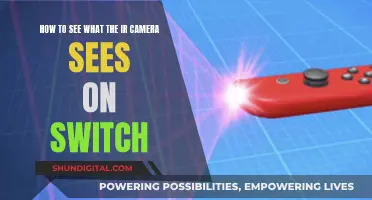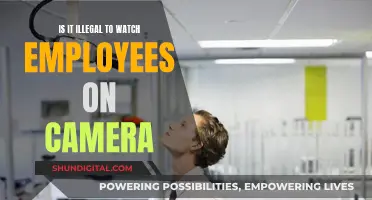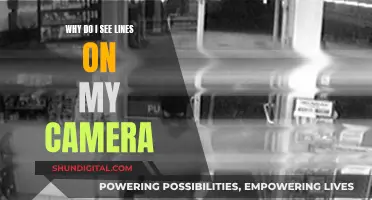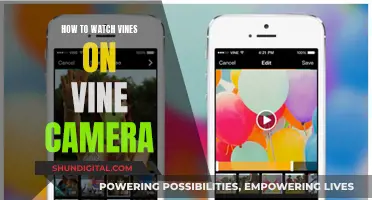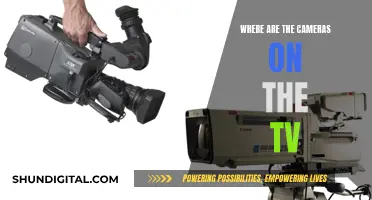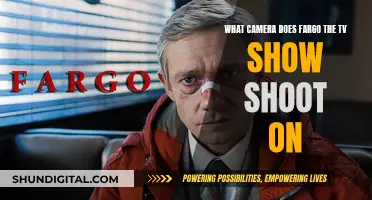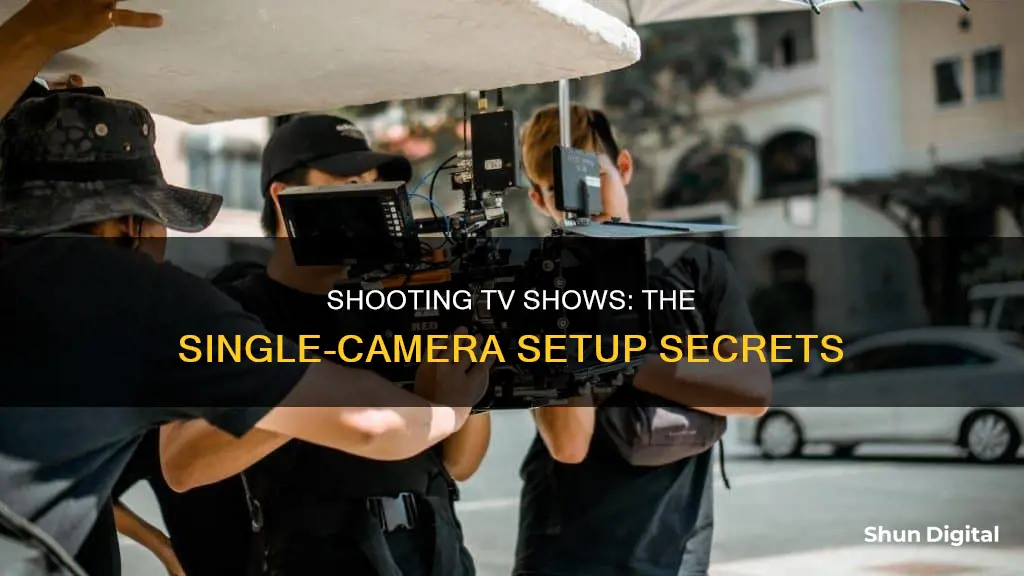
Single-camera TV shows are shot with the perspective of a single camera, though multiple cameras may be used to capture different angles. This setup is more commonly associated with films, giving the show a more cinematic feel. The single-camera setup is more time-consuming but gives the director more control over each shot. It also allows for more nuanced performances, with subtle eye rolls or facial expressions being captured in close-up shots. This style of shooting is often used for dramas, but comedies can also be filmed in this way, such as *The Office*, *Modern Family*, and *Superstore*.
| Characteristics | Values |
|---|---|
| Number of cameras used | One camera, but sometimes multiple cameras pointed in one direction |
| Camera movement | Moved and reset to get a new angle |
| Lighting | More optimised |
| Microphone and lighting rig placement | Easier to hide equipment |
| Recording capacity | Lower |
| Editing time | Longer |
| Flexibility | More |
| Cost | More expensive |
| Time | More time-consuming |
| Control | Director has more control over each shot |
| Script length | 22-32 pages, sometimes up to 35 |
What You'll Learn

Single-camera shows are shot like films, with cinematic angles and shots
Single-camera shows are often compared to films in terms of their production and writing. They are shot with a dedicated crew, including location scouts, and sets are built for frequently used locations. Directors try to match the style set in the pilot, while also experimenting with shots and angles.
In a single-camera setup, all shots and camera angles are taken using the same camera, or multiple cameras pointed in one direction, which are then moved and reset to get a new angle. This gives the director more control over each shot and allows for a more cinematic, movie-like style. The camera can move around so that it seems like the viewer is in the middle of the action, and the point of view can be anywhere, including outdoors.
If a scene cuts between two actors, the director will first point the camera at actor A, run part or all of the scene, and then repeat the process with actor B. This allows for parts of the scene to be removed in post-production if it is deemed too long. Sometimes, two cameras shooting from the same angle are used to capture a medium shot and a close-up during the same take.
Single-camera shows are mostly reserved for prime-time dramas, made-for-TV movies, music videos, and commercial advertisements. They are also used for comedies, with popular examples including *The Office*, *Modern Family*, and *Superstore*.
Galaxy Watch Camera Features: What You Need to Know
You may want to see also

Multi-camera shows are cheaper and faster to shoot
Multi-camera shows are faster and cheaper to shoot. This is because, with multiple cameras, you can shoot an entire episode in just a few hours. Multiple cameras allow for multiple takes to be captured at once, providing a variety of options for editing. The lighting setup is also simplified as the set only needs to be lit once to accommodate all camera setups.
In contrast, a single-camera setup requires more time and effort as each shot and camera angle is taken using the same camera, which needs to be moved and reset for each new angle. This process involves relighting the set and setting up alternative camera angles, which can be time-consuming and complex.
Multi-camera setups are particularly useful for sitcoms, soap operas, talk shows, game shows, reality TV series, and other shows with a live audience. This is because they allow for multiple perspectives to be captured simultaneously, which is essential when recording an ensemble of actors performing before a live audience. The multi-camera setup also facilitates the inclusion of a laugh track, which is a standard feature of many sitcoms.
While single-camera setups offer more control over each shot and are often preferred for feature film-like visual styles and the use of visual effects, they are more time-consuming and expensive. Therefore, multi-camera setups are generally favoured for shows that require faster production times and lower budgets.
Master Splinter Cell Blacklist: Sticky Camera Viewing Techniques
You may want to see also

Single-camera shows are more expensive and time-consuming
Single-camera shows are more time-consuming than multi-camera productions because they require each shot to be set up individually. This means that, for a scene cutting between two actors, the director must first shoot the entire scene from one angle, then move and reset the camera to capture the scene from the second angle. This process is repeated for each additional angle. Multi-camera productions, on the other hand, can capture all the necessary angles simultaneously, which is faster but leaves less room for directorial control.
Single-camera productions also require more time to be spent on lighting. Since the set only needs to be lit for one camera angle at a time, the lighting can be optimised for that specific shot, but it must be adjusted and reset for each new angle. With multi-camera productions, a compromise must be reached that works for all camera angles, but this means that no single shot will be lit as optimally as it would be with a single-camera setup.
The single-camera setup also requires more equipment to be moved and set up, which takes time. This includes not only the camera itself but also equipment like microphone booms and lighting rigs, which are easier to hide from a single camera.
All of these factors contribute to single-camera shows being more expensive to produce. The additional time spent on set-up and filming means higher costs in terms of crew salaries and studio time. The greater amount of equipment also adds to the overall expense of the production.
Furthermore, single-camera shows tend to have longer scripts, typically ranging from 22 to 35 pages, compared to 52 to 58 pages for multi-camera shows. This is because single-camera shows are shot more like films, without a live audience, whereas multi-camera shows are similar to live theatre, with the script formatted more like a play. The longer scripts for single-camera shows mean more time and money spent on writing, as well as potentially higher royalties or fees for the writers.
DPS and Privacy: Cameras Watching Your Every Move?
You may want to see also

Multi-camera shows are shot in front of a live audience
The multiple-camera setup is faster and less expensive than a single-camera setup. Multiple cameras can take different shots of a live situation as the action unfolds chronologically and is suitable for shows that require a live audience. Single-camera productions are unsuitable for viewing by a live audience as the action is not enacted chronologically and is shot in multiple takes and various setups.
The multiple-camera setup is commonly used for light entertainment, sports events, news, soap operas, talk shows, game shows, variety shows, and some sitcoms. Single-camera is mostly reserved for prime-time dramas, made-for-TV movies, music videos and commercial advertisements.
The multiple-camera setup is also the only way that an ensemble of actors presenting a single performance before a live audience can be recorded from multiple perspectives. This is especially important for sitcoms, which are usually shot in the multiple-camera setup.
A Guide to Operating HD IR Camera Watches
You may want to see also

Single-camera shows are more versatile in terms of locations
Single-camera shows can also have more scenes, which means more storylines and more characters. While a three-camera sitcom’s primary cast is usually limited to six or fewer, a single-cam sitcom like The Office can have an ensemble of fourteen or more.
Single-camera shows are also more cinematic, with more opportunities for experimentation with shots and angles. They are also more flexible in terms of editing, as choices can be made during the post-production editing process about when in the scene to use each shot, and when to cut between angles.
Smartwatch Compatibility with Dexcom: Bluetooth Camera Edition
You may want to see also
Frequently asked questions
A single-camera setup is a method in which all of the various shots and camera angles are taken using the same camera. In television production, both single-camera and multiple-camera methods are commonly used.
All of the various shots and camera angles are taken using the same camera, or multiple cameras pointed in one direction, which are moved and reset to get a new angle. If a scene cuts back and forth between two actors, the director will first point the camera toward one actor and run part or all of the scene from this angle, then move the camera to point at the other actor, relight, and then run the scene through from this angle. Choices can then be made during the post-production editing process for when in the scene to use each shot, and when to cut back and forth between the two angles.
Single-camera setups give the director more control over each shot. They also allow for more subtle humour, as the slightest roll of the eyes can be caught in a close-up reaction shot.


